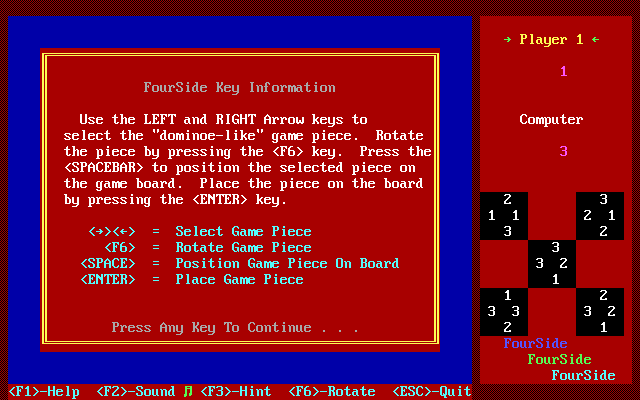Retro Replay Review
Gameplay
FourSide offers a deceptively simple yet deeply strategic tile-placement experience. Each player begins with a hand of five square tiles, each side bearing a number. Players take turns placing these tiles on a seven-by-nine grid, attempting to match adjacent numbers. The core mechanic—matching numbers to score points—is instantly accessible, but the permutations of tile orientations and board positions provide layers of tactical depth.
(HEY YOU!! We hope you enjoy! We try not to run ads. So basically, this is a very expensive hobby running this site. Please consider joining us for updates, forums, and more. Network w/ us to make some cash or friends while retro gaming, and you can win some free retro games for posting. Okay, carry on 👍)
The scoring system in FourSide adds a dynamic risk–reward element to every move. When you place a tile, you earn points based on how many sides touch existing tiles and the values on those sides. This encourages thoughtful placement: do you extend an existing chain for moderate points, or do you attempt to surround a high-value side for a bigger payout? Bonus and minus squares sprinkled across the grid spice things up further, granting or deducting twenty points on contact and forcing you to weigh immediate gains against potential setbacks.
FourSide accommodates different playstyles with its trio of difficulty levels and three modes—player vs. player, player vs. computer, and computer vs. computer. Beginners can lean on in-game hints to understand matching opportunities, while veterans can relish higher difficulty settings where a wider variety of tiles demands sharper spatial reasoning. The AI opponents scale intelligently, ensuring that each match feels fresh, whether you’re coaxing novices through their first game or dueling an expert algorithm that won’t give you an inch.
Graphics
Visually, FourSide embraces clarity over flashy effects, prioritizing readability and clean design. The grid is crisply rendered, with clearly marked bonus and minus squares that stand out without overwhelming the eye. Tiles feature bold numbers on each side, with distinct color-coding for easy identification of high-value or low-value edges, allowing you to scan the board at a glance and plan your next move.
While FourSide doesn’t push cutting-edge 3D graphics, its minimalist aesthetic serves the game’s strategic focus perfectly. Subtle animations—like a tile flipping into place or a celebratory glow when you hit a bonus square—add just enough flair to keep each turn feeling rewarding. The interface remains intuitive throughout, with drag-and-drop tile placement and rotation controls that respond snappily, ensuring you spend your time plotting tactics rather than wrestling with menus.
The sound design complements the visuals with gentle, unobtrusive background music and satisfying audio cues. A soft chime confirms a successful tile match, while a low buzz sounds if you accidentally place on a minus square. These audible signals reinforce feedback loops without intruding on concentration, making marathon matches comfortable whether you’re on a couch or commuting by train.
Story
As a puzzle-centric title, FourSide doesn’t weave a traditional narrative or lore. There’s no epic quest or unfolding drama—just two minds locked in a battle of numbers. For many players, this absence of storyline is a strength: the game zeroes in on its core premise of logical tile placement, unencumbered by cutscenes or character arcs.
That said, some users may miss having thematic framing or characters to invest in. FourSide offsets this by focusing on ambient touches, such as themed board skins (stone, wood, metal) and seasonal color palettes that evoke different moods without verbal exposition. These subtle visual cues hint at an unspoken “world” of FourSide’s puzzle arenas, inviting players to imagine their own backstory for the numbered pieces.
Ultimately, FourSide’s narrative is the one you create through gameplay. Each match tells a story of strategic comebacks, razor-thin margins, and triumphant tile placements. The competing goals—grappling for bonus squares while avoiding penalties—become the dramatic arc of every session. If you seek character-driven plots, this may feel sparse. But if you thrive on emergent gameplay moments, FourSide’s implicit story of numerical conquest will keep you hooked.
Overall Experience
FourSide shines as a compact, elegant strategy puzzle that’s easy to learn yet hard to master. The game’s straightforward ruleset makes it accessible to newcomers, while the interplay of tile rotation, number matching, and bonus penalties ensures that no two games feel the same. Whether you’re teaching friends around the coffee table or honing your tactics against a challenging AI, FourSide scales gracefully to match your skill level.
Replayability is high thanks to variable difficulty settings and the random draw of tiles. As you advance to higher tiers, the introduction of more diverse tile values keeps even veterans on their toes. In-game hints remain available for those seeking guidance, but serious players can opt to disable them for a purer competitive experience. And for spectators, the computer vs. computer mode turns each match into a lesson in strategy, offering insights into sophisticated tile-placement techniques.
In short, FourSide delivers a thoroughly engaging puzzler that rewards thoughtful planning and adaptability. Its polished interface, clear graphics, and balanced scoring mechanics coalesce into a satisfying whole. If you’re looking for a cerebral challenge—one that strikes a perfect balance between accessibility and depth—FourSide is a tile-based gem well worth adding to your collection.
 Retro Replay Retro Replay gaming reviews, news, emulation, geek stuff and more!
Retro Replay Retro Replay gaming reviews, news, emulation, geek stuff and more!








Reviews
There are no reviews yet.